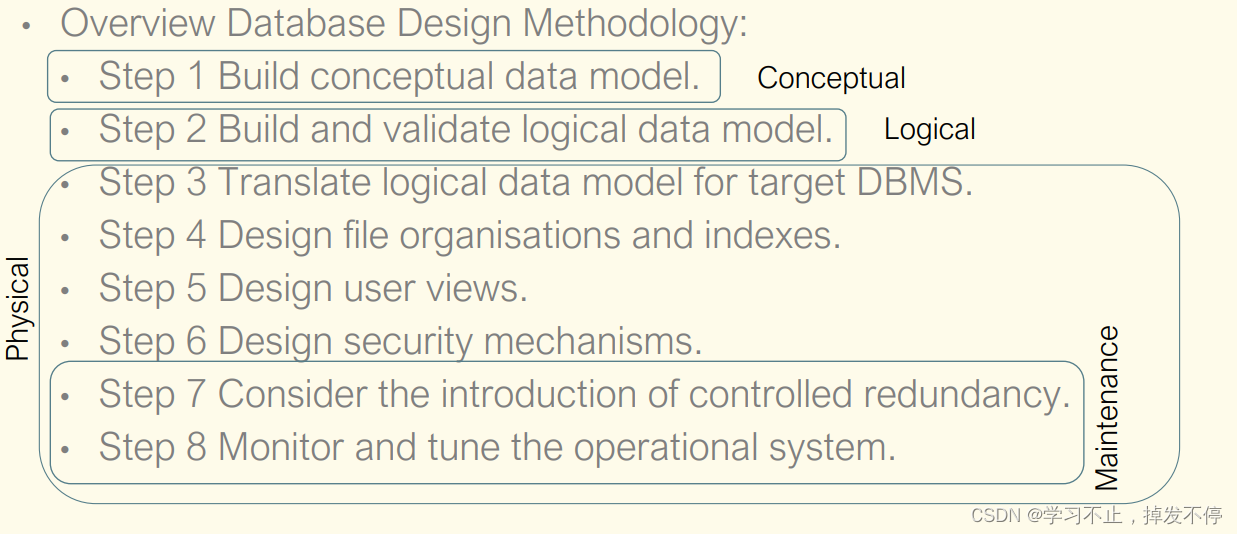1. Conceptual Database Design
The process of constructing a model of the data used in an enterprise, independent of all physical considerations.
• The goal of this phase is to produce a conceptual schema (which includes identification of the important entity types, relationship types, and attributes) for the database that is independent of a specific DBMS.
• We will use Entity Relationship (ER) modelling during this phase.

2. Build conceptual data model

2.1 Identify entity types
Identify entity types that we need to represent in the database.
Typical examples:
• People: staff, clients/customers, patients, members, owners, contacts, other individuals
• Objects: stock items, real estate, offices
• Organisations: firms (suppliers), departments, charities, clubs, committees
• Object classes: recordings, films, books, types of stock, biological species, work roles
• Events: concerts, examinations, lecture courses, consultations, sales
write it down clearly before drawing ER model
2.2 Identify relationship types
Identify the relationships between entity types that need to be recorded.
Typical examples:
• Ownership: person owns object
• Lines of command: person supervises person
• Participation: person participates in event
• Part of relationship: item is part of order; person belongs to organisation
• Location: house is located in region
• Personal: person is married to person; person is parent of person
sometimes we need to consider the time dimension of the relationship
2.3 Identify and associate attributes with entity or relationship types
Attributes can be identified where a noun or a noun phrase is a property, quality, identifier, or characteristic of one of the entity or relationship types previously found.
Identify whether attributes are:
• Simple/composite.
• Single/multi-valued.
• Derived.
multi-valued attributes cannot be the primary key.
2.4 Documenting attributes
Record the following information for each attribute:
• attribute name and description;
• data type and length;
• any aliases that the attribute is known by;
• whether the attribute must always be specified (in other words, whether the attribute allows or disallows nulls);
• whether the attribute is multi-valued;
• whether the attribute is composite, and if so, which simple attributes make up the composite attribute;
• whether the attribute is derived and, if so, how it should be computed;
• default values for the attribute (if specified)
2.5 Determine attribute domains
A domain is a pool of values from which one or more attributes draw their values.
A domain specifies:
• allowable set of values for the attribute;
• size and format of the attribute.
2.6 Guidelines for choosing a primary key
- Select the candidate key
- with the minimal set of attributes;
- that is less likely to have its values changed;
- that is less likely to lose uniqueness in the future;
- with fewest characters (for those with textual attribute(s));
- with the smallest maximum value (for numerical attributes);
- that is easiest to use from the users’ point of view.
 构建企业级概念数据模型:ER设计的关键步骤
构建企业级概念数据模型:ER设计的关键步骤





 本文详细介绍了概念数据库设计过程,包括识别实体类型、关系类型、属性及其文档化、确定主键等步骤,使用ER模型来创建独立于特定DBMS的数据库概念模式。
本文详细介绍了概念数据库设计过程,包括识别实体类型、关系类型、属性及其文档化、确定主键等步骤,使用ER模型来创建独立于特定DBMS的数据库概念模式。
















 1031
1031

 被折叠的 条评论
为什么被折叠?
被折叠的 条评论
为什么被折叠?








